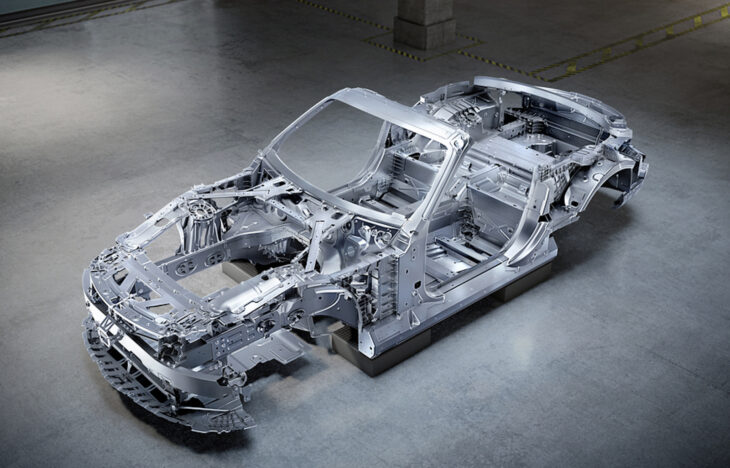The new Mercedes AMG SL roadster architecture consists of the combination of an aluminum space frame with a self-supporting structure. The designers were asked to develop the AMG-SL’s bodyshell without relying on preceding SL model designs or components.
The requirements for the bodyshell architecture of the new luxury roadster were considerable and demanded a more comprehensive scope than previous models. In particular, the basic layout with 2+2 seats and the potential to accommodate a wide range of drive systems were realized here for the first time in an SL, a task that presented the developers with completely new and complex challenges. The developers aimed to present the driving performance characteristic of the brand with a focus on lateral and longitudinal dynamics.
“The development team in our bodyshell design area was faced with an extremely appealing, but also challenging task. When we were commissioned to undertake the overall development of the new SL, we started from scratch, without building on any existing structure, said Jochen Hermann, chief technical officer of Mercedes AMG GmbH. “We can be justifiably proud of the result. On one hand we have managed to reconcile the high package demands, while on the other we have been able to achieve excellent rigidity values in all areas in conjunction with a favorable weight, so providing the basis for agile driving dynamics and exceptional comfort.”
High Aluminum Content and New Fiber Composites
In the new SL, the intelligent material composition of aluminum, steel, magnesium. and fiber composites ensure the highest possible rigidity in conjunction with low weight. Optimized material cross-sections and sophisticated component shapes create space for comfort and safety features, the sophisticated technology and the soft top.
Other specific measures include aluminum thrust panels on the underbody and function-integrated struts at the front and rear. The instrument panel support is made of magnesium, and part of the front module cover bridge is a fiber composite material with a mixture of glass fibers and carbon.
Tailor-Made Cast Aluminum
Cast aluminum components are used at the nodal points where forces come together or where functions are highly integrated, i.e. where large forces have to be transferred. Cast components have the advantage of enabling the specific discharge of forces, making it possible to vary wall thicknesses locally according to the loads the individual parts will encounter. Accordingly, areas of greater rigidity can be realized where required, like at the chassis connections. Moreover, only the necessary amount of wall thickness was used in each component to save weight in the areas subject to lower forces.
Compared to the previous model series, the torsional stiffness of the bodyshell structure increased by 18%. The transverse rigidity is 50% higher than that of the AMG GT Roadster, while the longitudinal rigidity is 40% higher. The improved rigidity for the chassis connection ensures sporty driving performance with precise handling and high agility. The weight of the bodyshell without doors, hood, and trunk lid is around 595 lbs.
The entire vehicle concept is designed towards the lowest possible center of gravity. This applies both to the low connection points for the powertrain and axles, and to the lowest possible arrangement of the rigidity- relevant bodyshell structure. Examples of this are the connections between the front and rear sections and the passenger safety cell, with their high flexural strength and torque rigidity, systematically realized via force paths that are as low as possible.
Quality and Processing at the Highest Level
Modern joining techniques — such as MIG welding, laser welding, punch riveting, blind riveting, MIG soldering, glued seams, and flow hole bolts, as well as precise toolmaking — raise the level of the bodyshell value appeal to the highest level.
Despite the extremely high quality requirements, the development was implemented at a record-breaking pace, with the pre-development was done in only three months. It took less than three years from the time the commission was given to a team of initially just six people to the release of the series. The high quality of the software used in the digital development made it possible to give the go-ahead for the production of the series tools without a physical prototype of the chassis. The structural verification vehicle, which is of immense importance for passive accident safety, received internal top ratings in the first real crash test.
Production of the new SL will take place at the Mercedes plant in Bremen, Germany.

